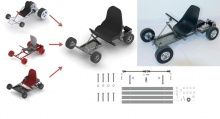MIT's 'Fab By Example' lets you quickly create, 3D print thousands of complicated designs

3D printing could one day help democratize manufacturing, but it is still a long way to go before consumers really understand how the technology works and what they can benefit from it. Part of the problem is that many 3D printed items are far too complicated for users to digitally design.
Although you can order some of the 3D designs online, but to find a part or object that match exactly to your specifications is not easy, or simply not possible.
Now, a team led by researchers from MIT's Computer Science and Artificial Intelligence Lab (CSAIL) has developed "Fab By Example," a data-driven method to help people design products. "Fab By Example" includes dozens of distinct template models that allow users to customize any complex items, such as cabinets, jungle gyms, and go-carts.
"When we design things on a computer, the question arises of how to manufacture them in the real world with the necessary physical parts — wood, glass, screws, hinges, bolts and all," said project lead Adriana Schulz, a PhD student in CSAIL. "For casual users, creating such a detailed model is not just time-consuming, but it's actually more or less impossible unless you know something about mechanical engineering."
Fab By Example's intuitive drag-and-drop interface lets you mix and match materials — and position, align, and connect the different parts — without worrying if the design is actually feasible.

"The technology allows you to design and fabricate practically any off-the-wall idea that's bouncing around your head," Schulz said.
MIT revealed that the system has a growing database of templates, and each model is composed of hundreds of parts, down to the individual screws of a go-cart. The models are all "parametric," meaning that they can be manipulated to take on a nearly infinite number of different shapes. Schulz says that the team's database of templates is currently meant to be illustrative, and could evolve to include models of cars, houses, or practically any fabricable object.
The system is designed for anyone with simple computer skills. For your project, Fab By Example lets you see what specific parts are needed and how much they cost; you could then order the materials right from the database, with the option to optimize for price or speed-of-delivery. Schulz says in the future the database could even be tied to an installation service that would send someone to your home to assemble the object for you.
The work was developed by Schulz; CSAIL postdocs David I.W. Levin and Pitchaya Sitthi-amorn; Wojciech Matusik, an associate professor of electrical engineering and computer science at MIT; and Ariel Shamir, a professor at the Interdisciplinary Center Herzliya in Israel. The team will be presenting its system at this month's Siggraph graphics conference.
In the future, Schulz says that the team will be working with CSAIL colleagues to incorporate designs for robots that could be assembled, customized, and even printed from home.







